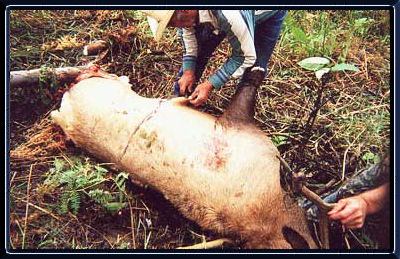

How to Cure Real Corned Beef, Venison, or Almost any Red Meat
This is probably best with a nice piece of brisket from well aged beef, elk, or moose. A good piece of shoulder or rump is also fine. First you need a crock that is big enough to hold the meat you want to cure, or some other large, clean and non-reactive container. First make the brine. For three gallons of brine, add to your crock:
1 1/2 lb. Kosher or other pure salt
5 oz. Sugar
2 Tblsp Peppercorns
1 Tblsp Whole Cloves
6 Bay Leaves
10 Tblsp Pickling Spices
2 Onions, Sliced
12 Cloves Garlic, crushed
10 Small Hot Dry Red Chiles
Enough cold pure water to make three gallons
Stir until sugar and salt are dissolved. Add meat, do not pack tightly, it needs some room. If the brine will not cover the meat, add more brine made up in the above proportions. The original recipe included 1 oz. of Sodium Nitrate and 1/4 oz. of Sodium Nitrite. This will give the finished product a nice red look when cooked, but is cosmetic only in this regard. A half ounce or so of the Nitrate is also certain protection against the possibility of Botulism, but if you use the recommended amounts of salt and sugar, do not pack the meat tightly, and take it out of the crock and cook or freeze it when the curing process is over, there is no chance ofanaerobic conditions, and therefore no chance of botulism.
When the meat is in the crock, cover it with a plate, and put something on the plate heavy enough to ensure the meat will stay submerged in the brine. Tie a cloth over the top of the crock to keep out bugs. Store in a cool spot, as close to 38 degrees as you can get. If you must keep it in a warmer place, for every 15 degrees over 38 add 1/3 more salt to the brine. Turn the meat every few days. A scum of white mold may form on top, but that is normal. The meat will be ready to cook in 2-3 weeks. What you don't use immediately freezes well.

|